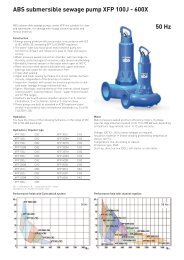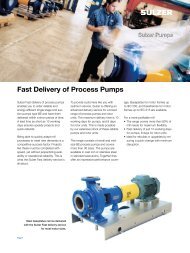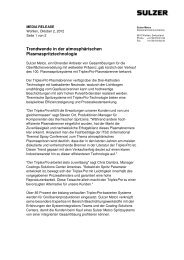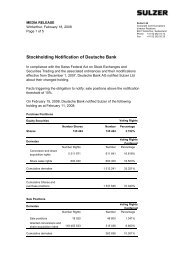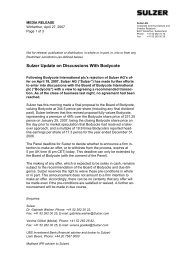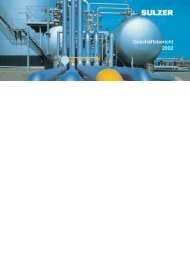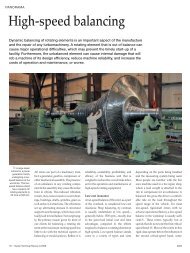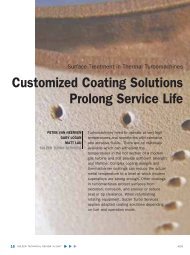Testing and quality
Testing and quality
Testing and quality
Create successful ePaper yourself
Turn your PDF publications into a flip-book with our unique Google optimized e-Paper software.
year, the test setup needs to be st<strong>and</strong>ardized<br />
with a high turnover. The required<br />
rapid setup <strong>and</strong> breakdown is achieved<br />
with modular pump interface piping<br />
that can be quickly rotated into position<br />
using custom-built rotating assemblies<br />
holding the required range of suction<br />
<strong>and</strong> discharge pipe sizes.<br />
At the factories there are test beds for<br />
each pump type with multiple test beds<br />
for different sizes. Apart from a general<br />
test station for vertical pumps, process<br />
pumps, <strong>and</strong> multistage pumps with<br />
power up to 500 kW, the newest <strong>and</strong><br />
largest operation test bed of Sulzer<br />
Process Pumps is the test station for large<br />
process pumps. In this test bed, mea -<br />
surements can be carried out with high<br />
flow together with low pressure on the<br />
suction side. Such tests with pressures<br />
close to the vapor pressure in the suction<br />
pipe in combination with high flow rates<br />
are very important in the design phase<br />
of high specific speed pumps. One use<br />
of this low-pressure test rig is the simulation<br />
of pumping conditions in large<br />
evaporators.<br />
Energy efficiency<br />
Very similar test beds are available<br />
in the product development test bed<br />
in the Kotka research center 1. The<br />
medium-consistency pulp pump loop—<br />
with power up to 600 kW, flow rates up<br />
to 1200 l/s, <strong>and</strong> pressures up to 25 bar—<br />
conforms to the requirements of the pulp<br />
2 Energy recovery system.<br />
<strong>and</strong> paper industry. In this loop, the<br />
usual test materials are multiphase suspensions<br />
with gas, most commonly a<br />
mixture of water, pulp fibers, <strong>and</strong> air.<br />
To optimize the energy efficiency of<br />
the tests, equipment for energy recovery<br />
will be installed in the multistage pump<br />
loop in Finl<strong>and</strong> 2. A Pelton turbine connected<br />
to the same shaft train as motor<br />
<strong>and</strong> pump will recover the high pressure<br />
created by the pump. This setup will<br />
allow testing of multistage pumps at<br />
2.7 MW power while taking only 1.4 MW<br />
from the grid. At optimum conditions,<br />
only one quarter of the pump energy is<br />
taken from the grid. At the same time,<br />
the turbine reduces pressure with high<br />
efficiency <strong>and</strong> with much lower noise<br />
emission than when dissipating—<strong>and</strong><br />
thus losing—the energy in the valves.<br />
The hydraulics group in Finl<strong>and</strong> has<br />
optimized both the energy efficiency of<br />
the new multistage pump for reverse<br />
osmosis <strong>and</strong> of the associated test bed.<br />
This test bed will be used to validate the<br />
hydraulic <strong>and</strong> mechanical improvements<br />
to the existing multistage pump range<br />
<strong>and</strong> to develop new pump sizes. Needle<br />
valves with electric actuators control the<br />
turbine of the energy recovery system,<br />
which means the test loop operator<br />
using a Pelton turbine will see no difference<br />
in the loop operating philosophy.<br />
A test series for a pump with a drive<br />
power requirement of 1.4 MW will be<br />
carried out with just 400 kW of loss.<br />
Comparisons with a traditional test<br />
setup shows that the test rig will save<br />
8000 kWh of electric power in a single<br />
day. As a usual test series for one pump<br />
hydraulic takes about 20 days, with the<br />
new energy saving test rig, the environmental<br />
benefits <strong>and</strong> cost savings are<br />
significant.<br />
<strong>Testing</strong> before delivery<br />
In addition to aiding the development<br />
of new products, testing also ensures the<br />
<strong>quality</strong> of the output. All pumps leaving<br />
the production plant of Sulzer in Leeds<br />
are fully tested to both international st<strong>and</strong>ards<br />
<strong>and</strong> customer-specific requirements.<br />
On this test bed, highly engineered<br />
pumps <strong>and</strong> packages (including the<br />
contract driver) for the upstream oil <strong>and</strong><br />
gas industry are tested before delivery<br />
to site.<br />
This enormous facility is equipped<br />
with the required systems to test pumps<br />
driven by gas turbines of up to 30 MW,<br />
large diesel engines, <strong>and</strong> high-voltage<br />
electric motors. Recent modifications<br />
to the power grid gave Sulzer in the<br />
UK access to 45 MW of electrical power<br />
<strong>and</strong> two in-house variable-speed drives<br />
(VSD). The test bed provides sufficient<br />
space to install multiple skids, including<br />
pump <strong>and</strong> driver, <strong>and</strong>, if required, the<br />
contract VSD plus all of the support<br />
equipment, such as mechanical seal <strong>and</strong><br />
lubrication systems.<br />
TESTING AND QUALITY<br />
3 With seven singular test loops, the test bed in Oberwinterthur<br />
is highly flexible.<br />
Sulzer Technical Review 1/2011 |<br />
7



